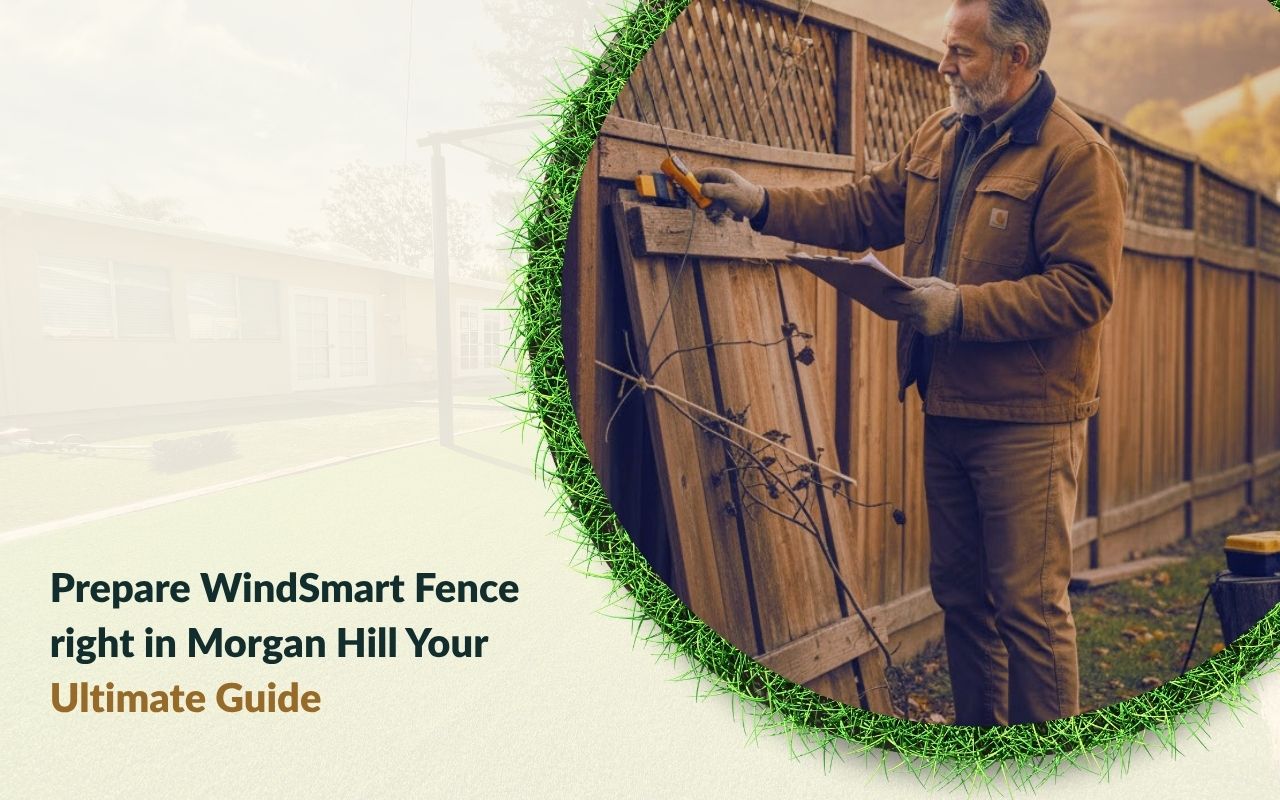
Launch your outdoor space transformation with the perfect Wind-Smart Fence Prep in Morgan Hill. Many homeowners love a private, beautiful garden, yet they forget about preparing fences for harsh weather. Because fall winds can be unpredictable, this season is ideal for reinforcing posts, weatherproofing wood, and planning privacy and airflow gaps. These simple tasks keep your fence strong and good-looking.
As you handle these tasks, your fence offers privacy and stands firm against strong gusts. At the same time, you can enhance your backyard’s mood with subtle lighting on modern fences that frame evening gatherings. This guide walks you through each step of Wind-Smart Fence Prep in Morgan Hill with clear, simple tips and friendly advice.
Assessing Fence Stability and Reinforcement
Begin your fence check with a detailed fall fence inspection to spot loose boards, leaning posts, or early signs of rot. Look for gaps where wind can catch and shake the fence. Also note any places where slats have pulled away from rails or where posts have shifted in the ground. Checking these weak spots now saves effort and cost when storms arrive.
A careful inspection highlights areas that need attention before you reinforce posts or replace damaged wood. Carry out small repairs by tightening screws, hammering nails back in place, and adding metal brackets where needed. When you reinforce posts, dig around the base, check depth, and steady each one with gravel and fresh concrete for better strength.
- Test each post by gently pushing it from side to side.
- Mark any wobbly or cracked sections for repair.
- Recheck the fence line after fixes to confirm stability.
Weatherproofing Techniques for Fence Longevity
Perform a full cleaning before you apply any sealant or stain to your weatherproof wood fence. Use a gentle pressure wash or scrub the boards with a brush and soapy water to remove dirt, mold, and old finishes. Then let the fence dry for at least twenty-four hours so the sealant can bond properly.
Choose a quality weatherproofing product that adds a protective coat, repels moisture, and blocks harsh UV rays. Apply the sealant with a wide brush or roller, working from top to bottom and paying attention to post bases and rails. Two thin coats give better coverage, so always allow the first layer to dry before the second.
- Check the product label for drying and recoat times.
- Plan your work for a dry, mild, and calm day.
- Inspect the finish each year and reapply as needed.
Choosing the Right Materials for Wind-Resistant Fencing
Select fencing materials that balance strength and flexibility to stand up to Morgan Hill’s breezy conditions. Hardwoods like cedar and redwood resist decay and pests, while pressure-treated pine offers budget-friendly durability. Metal options such as aluminum or steel pickets also hold up in high winds, yet they need sturdy posts and brackets to prevent bending or rattling.
Consider composite panels for a low-maintenance option that will not splinter or rot. Vinyl fences give another easy-care choice, though they may flex more in strong gusts. Finally, choose quality hardware such as galvanized screws, metal post anchors, and corrosion-resistant hinges so your Wind-Smart Fence Prep in Morgan Hill stays secure.
Incorporating Privacy Features in Your Fence Design
Improve seclusion without blocking every breeze by mixing solid panels with slatted areas or lattice tops. Solid boards give full privacy, while lattice sections invite light and gentle airflow. Place taller boards at the bottom and shorter decorative pieces on top to create a layered look that feels open yet still protected.
Use plants like climbing vines or tall shrubs along the fence to boost privacy and soften lines. This greenery cuts wind noise and builds a rich backdrop. For layout ideas that blend fences and plants, explore modern backyards that feel both stylish and relaxed.
Enhancing Airflow for Wind-Smart Fences
Install horizontal slats with small gaps so breezes can pass through while strong gusts stay under control. These openings reduce pressure on the fence and lower strain during windy days. Properly spaced boards can even cut wind resistance compared with fully solid panels, yet they still feel private and secure.
Build in privacy + arrow gaps at key spots, such as along the top line or between fence sections. This wind-smart design keeps your garden from feeling stuffy and supports steady airflow. As a result, plants stay healthier and your outdoor space remains comfortable in every season.
Installation of Thoughtful Lighting Fixtures
Place solar-powered or low-voltage LED lights along the fence line to brighten walkways and highlight design details. Position fixtures every few feet, paying extra attention to corners, gates, and seating areas. This plan supports safe movement after dark and adds a gentle glow to evening gatherings with friends and family.
Choose waterproof, weather-resistant fixtures made for outdoor use. For a sleek style, install lighting on modern fences that mounts directly to panels or posts. Warm-toned LEDs feel welcoming, while adjustable spotlights let you showcase plants, artwork, or textured fence sections and turn the structure into an inviting backdrop.
- Combine path lights with fence-mounted fixtures for layered lighting.
- Use timers or smart controls to manage energy use.
- Test light placement at night and adjust angles to reduce glare.
Maximizing Safety Measures for Your Fence
Choose smooth, rounded posts and hidden fasteners to reduce snags and sharp edges. This small decision helps prevent injuries when kids or pets play near the fence. Also secure each gate with reliable latches and self-closing hinges so it cannot swing open during high winds.
Install post caps to shield wood ends from moisture and rot, extending the life of the fence. Add reflective strips or glow-in-the-dark markers near the base so you can see the boundary at night and avoid trips. These simple upgrades build safety and durability into your daily routine.
Seasonal Maintenance Tips for Wind-Resistant Fences
Schedule a quick check each season to spot loose boards, rust on metal parts, or peeling sealant. Tighten screws, replace worn components, and reapply finish when needed so the fence looks good and works well. A little careful upkeep now helps you avoid larger repairs later.
After storms, inspect for debris piled at the base and clear away leaves or branches. Keeping the area around the fence clean reduces trapped moisture and insect activity. Trim back plants that rub against the surface so they do not scrape or weaken the materials over time.
- Review the fence line at the start of each season.
- Clean away soil or mulch that touches the boards.
- Record repairs so you can track repeat problem areas.
Eco-Friendly Practices for Sustainable Fence Care
Select water-based stains and sealants with low VOC levels to reduce environmental impact. These products dry quickly and release fewer harsh chemicals, which keeps the air cleaner for your family and the planet. Look for trusted certifications, such as GreenGuard or EcoLogo, to guide smart product choices.
Harvest rainwater to rinse the fence before cleaning or sealing so you use less tap water. Recycle old boards into garden planters or compost bins and give them a second life. By following these eco-friendly habits, your Wind-Smart Fence Prep in Morgan Hill will be as kind to the earth as it is strong in the wind.
Frequently Asked Questions
How often should I plan a fall fence inspection?
Plan a fall fence inspection at least once a year, ideally before the windiest weeks arrive. During this visit, walk the full fence line, look for loose boards or rusted parts, and schedule repairs quickly. Regular checks keep small issues from turning into major structural problems during strong seasonal storms.
When do I need to reinforce posts instead of replacing them?
You should reinforce posts when they are slightly loose but not rotten or cracked. In many cases, digging around the base, adding fresh gravel for drainage, and pouring new concrete is enough. However, if the wood is soft, badly split, or tilting at a sharp angle, replacing the post is usually safer.
What is the best way to weatherproof a wood fence for windy seasons?
The best way to weatherproof a wood fence is to clean it well and then apply a quality sealant. First remove dirt, mold, and peeling finish so new products can bond. Next, use two thin coats of stain or sealant and focus on rail ends and post bases, where moisture and wind wear hit hardest.
How can I balance privacy and airflow in a windy backyard?
To balance privacy and airflow, mix solid sections with open designs such as lattice tops or spaced slats. In key areas, add privacy + arrow gaps that break strong gusts while allowing breezes through. You can also combine tall shrubs with partial panels so the yard feels sheltered yet still fresh and airy.
What type of lighting works best on modern fences?
Lighting on modern fences works best when it is subtle, efficient, and weather-ready. Low-voltage or solar LED fixtures that mount directly to posts create clean lines and steady light. Combine warm wall lights, slim path fixtures, and a few focused spotlights to guide movement, highlight textures, and keep energy use under control.
Enjoying Your WindSmart Fence in Morgan Hill
With these practical steps, your Wind-Smart Fence Prep in Morgan Hill will not only stand up to strong winds but also look neat and feel safe. Regular fall fence inspection, steady reinforcement of posts, and smart material choices form the base of a long-lasting, reliable structure.
Combine weatherproof wood fence treatments, thoughtful lighting on modern fences, and eco-friendly care so you enjoy steady privacy, smooth airflow, and peace of mind all year. When you want expert help with layout or repairs, contact Jardinland Landscaping Services for a tailored plan. Embrace Wind-Smart Fence Prep in Morgan Hill and turn your outdoor area into a resilient retreat.
